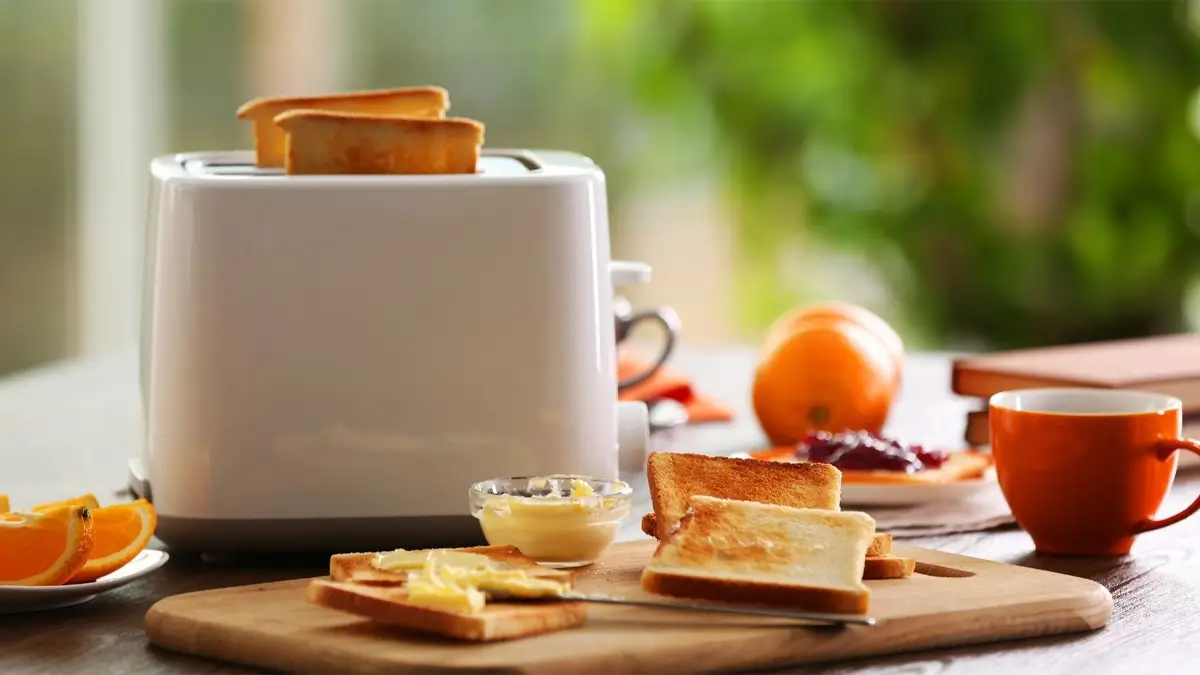Boutonniere: A Detailed Exploration of a Timeless Floral Accessory
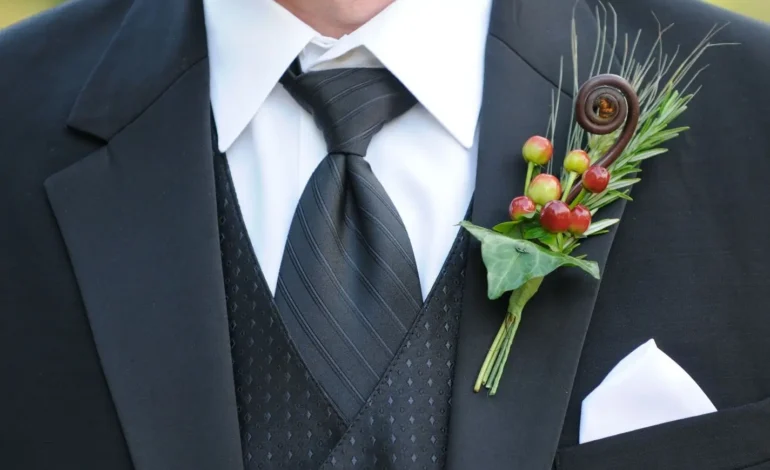
Introduction
A boutonniere is a formal flower arrangement that is usually placed on a buttonhole and is usually worn by men. The name “boutonniere” derives from the French word boutonnière meaning buttonhole because it was worn in the buttonhole of a jacket. The boutonniere remains a visible, meaningful symbol of refinement, tidiness, and importance to this day, despite how compact it may be. In this article, the authors are going to discuss the history behind the boutonniere, its meaning, and its role in current events and ceremonies.
The History of the Boutonniere
Ancient Beginnings
This art of wearing a little flower has a long history with the Greeks and the Romans who used to wear them. During these periods, men used flowers and wore small bunches of flowers to their chests especially near the heart to ward off evils and ensure victory in battles, among other reasons. For these floral arrangements, people believed they possessed magical qualities and they served to protect.
Medieval Europe
In the Middle Ages boutonnieres took on a different use as flowers were placed in the uniforms to signify that the man was a lady’s man or as a sign of loyalty to the country or the fight. It was also common for warriors to disclose their identity or that of their lover by wearing the opposite colors or flowers. This made the boutonnieres a symbol of loyalty, bravery, and love in their relationship.
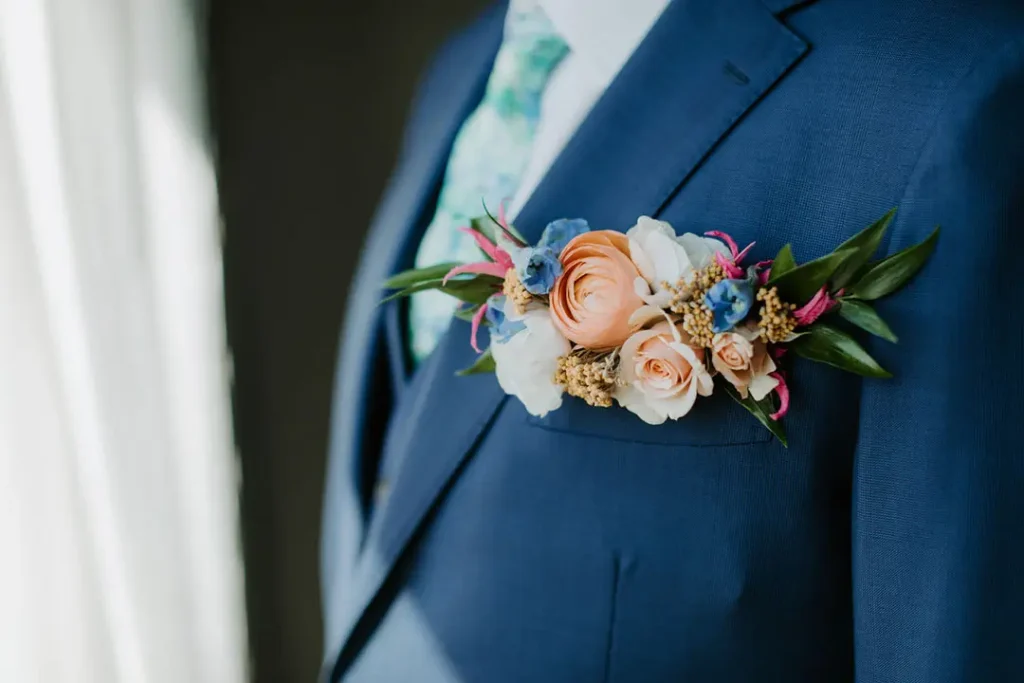
The Victorian Era
The tradition of wearing boutonnieres in Victorian England shifted and people started wearing boutonnieres to reflect the fashionable and elite class. It was considered appropriate to wear them during black tie events or any elegant occasion that required the wearer to be a man of status. During this period, there emerged a practice of using flowers to convey messages in what is known today as floriography. In this language of the flower, every bloom had its unique message, and arranging a boutonniere of a specific flower meant to express emotions such as love, admiration, or sorrow without actually using words.
As time passed, the boutonniere transitioned from being a symbol of war and protection to one of fashion, elegance, and charm.
The symbolism of the Boutonniere
It may be small, but the message conveyed by this boutonniere is always significant. Flowers themselves that are used in boutonnieres could also have various meanings depending on the history and traditions associated with them.
Roses: The rose remains the most common flower used for boutonnieres, particularly during wedding ceremonies, to express the love of beauty and romance. In general, a red rose symbolizes passion; a white rose symbolizes purity.
Carnations: Carnations are another popular flower for boutonnieres; they symbolize appreciation or love. A red carnation means you love the person very much, a white carnation means you are in love with this person, and a pink carnation means you are thankful to this person.
Orchids: Delicate and elegant, orchids are employed to depict power, allure, and opulence. Fashioned as part of a man’s accessories, orchids prompt a powerful fashion statement.
Lily of the Valley: A small and sweet scent of the flower, the lily of the valley symbolizes joy, modesty, and innocence. This flower is widely utilized in royal weddings and similar royal occasions.
Sunflowers: While not as conventional, sunflowers convey a happy and uplifting message to the recipient, indicating love, devotion, and happiness.
This shows that the symbolism of boutonniere makes it a unique ornament, the meaning of which is often consciously expressed concerning the feelings or purpose of the person wearing it.
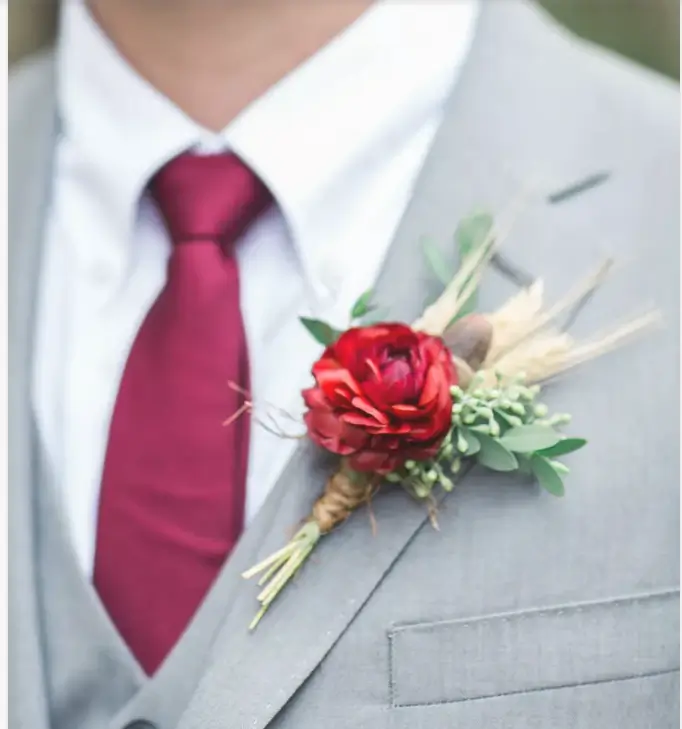
The Role of Boutonnieres in Modern Events
Boutonnieres are used primarily on formal occasions where the issue of styles is of utmost priority.
Weddings
The groom, groomsmen, fathers of the bride and groom, and other close male relatives of the couple wear boutonnieres at a wedding function. The groom’s boutonniere typically corresponds to the bride’s bouquet to express the couple’s togetherness. Boutonnieres are perhaps worn most often in weddings, choosing the flower as a symbol of love, partnership, and newly wedded marriage.
Proms and Dances
Proms are a large event in high school where students wear formal clothing. Ladies wear corsages and men’s boutonnieres which are small flower arrangements that are pinned to the clothing or worn around the wrist. The boutonniere is quite significant in the prom ritual as it is a sign of the experience and bonding between the couple attending the occasion.
Formal Ceremonies and Award Events
Boutonnieres are used in formal functions like award ceremonies, state dinners, and graduation ceremonies. Boutonniere is an elegant accessory to wear with a suit or tuxedo to respect the occasion and also bring elegance to the outfit. For instance, celebrities, politicians, or business magnates are always associated with a boutonniere, especially during official ceremonies.
Remembrance and Memorial Days
Boutonnieres are also employed as tokens of recall. For instance, wearing a poppy boutonniere during Veterans Day or Memorial Day is a sign of respect to those heroes who have laid down their lives for their nation. One of its parts is called the ‘Flanders Fields’ and it uses the symbol, the red poppy, to represent blood that was lost during the war and as a way of paying respect to the deserving victims.

How to Choose the Right Boutonniere
Choosing a correct boutonniere is somewhat influenced by the occasion, the garment to be worn, and the meaning of the flower.
Consider the Event
- Any flowers worn by the groom, a boutonniere, should be similar in color and form to the bride’s bouquet. The boutonnieres of the groomsmen are usually miniatures of the groom’s boutonnieres to achieve a uniform appearance for the wedding party.
- When it comes to proms, the boutonniere must complement the corsage of the date. It might be advisable to select flowers that would harmonize with the color of their dress or accessories.
- In case you are performing flower remembrance events then go for flowers with some significance behind them, for instance, red poppy or white lily.
Choose the Right Flower
The significance of the flowers is different, and getting the right one tops up the event in a special way. Flowers such as roses for love, carnations for admiration, and orchids for luxury are suitable for such occasions.
Match the Outfit
Boutonnieres are usually partnered with formal occasions, therefore, the floret must correspond to the color and design of a suit or tuxedo that is worn during the occasion. The boutonniere should not be too dominating, but rather should complement the outfit with a touch of color and elegance.
How to Wear a Boutonniere
A boutonniere can complete the image of a man in formal attire if worn in the right manner:
Placement
A boutonniere is likewise worn on the left side of the jacket with beautiful perfume, normally, just above the heart. If the jacket has a buttonhole, the stem of the flower is passed through it. In case there is no buttonhole present, the boutonniere can be attached to the lapel using some pins.
Pinning the Boutonniere
Secure the boutonniere with a floral pin that has a sharp edge. Ensure the flower is pointing in the outward direction and is arranged in an upright manner. The pin must pass through the stem and the material of the lapel which would hold the boutonniere in place.
Positioning
The boutonniere must be positioned at the midline at the level of the wearer’s collarbone, and not up or down. It should also be located in a manner in which the stem and wiring or the tape that is used to join the boutonniere will not be visible.
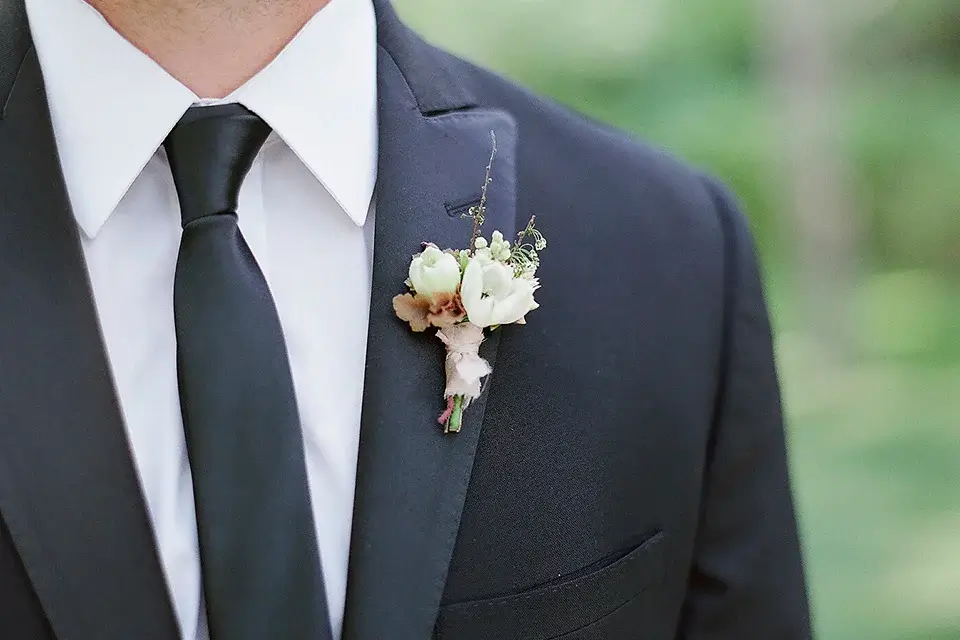
DIY: How to Make Your Boutonniere
Boutonniere making is another home craft project that is quite simple to do and can enhance your appearance on any formal occasion.
Materials Needed:
- A small flower (like a rose, carnation, or daisy).
- Natural elements, such as foliage, leaves, or sprigs of herbs
- Floral wire and floral tape
Step-by-Step Instructions:
- Choose the Flower: Select a small flower with the stem being hard and firm. Cut the stem to about 2 inches above the base.
- Add Greenery: Try placing a few small leaves or herbs at the back of the flower to frame it properly.
- Secure with Wire: Secure the flower and greenery using floral wire by trapping the stems and wrapping them around them properly.
- Wrap with Floral Tape: Abraca the upper side of the floral wire with green floral tape to ensure that the wire gets a perfect finish.
- Attach the Pin: Place the small safety pin and then pin the boutonniere to the jacket.
Conclusion: A Timeless Symbol of Style and Tradition
The boutonniere is not just a floral element but it has so much more significance. It has a history of centuries, symbolic meaning, and even a scent of refined words. It is unlikely for a wedding or prom dress to be complete without a spruce of a boutonniere, not to mention some other formal event where such an accessory could make you feel even more the royalty. As the trends come and go, the boutonniere remains a timeless piece that links the present to the past in the most beautiful way.
This content is now a detailed guide on boutonnieres that would be informative to teach 6th-grade students and others regarding this elegant tradition! Feel free to text me if you want any modifications.
FAQ’s
1. What is a boutonniere?
A boutonniere is a small ornamental buttonhole that is normally worn by men on the lapel of their jackets during formal occasions. It is usually hung on the lapel of a suit or jacket. The term we are discussing is boutonniere and it is derived from the French language, where boutonnière means buttonhole.
2. What is the historical significance of the boutonniere?
It used to be that this boutonniere had its origins back in the year one. Men in ancient Greece and Rome used to wear small flowers for protection from evil spirits and good fortune. In medieval Europe, people used them to show devotion and some warriors used flowers in their armor to signify their loyalty to their leaders. It grew to become famous during the Victorian Period when it was associated with beauty and fashion.
3. What flowers are commonly used in boutonnieres, and what do they symbolize?
- Some common flowers used in boutonnieres and their meanings include: Some common flowers used in boutonnieres and their meanings include:
- Roses: Love and romance
- Carnations: Admiration and affection
- Orchids: Strength and luxury
- Lily of the Valley: One’s Emotions and virtues Every flower has a special significance as well as is worn on the boutonniere.
4. On what occasions are boutonnieres typically worn?
Boutonnieres can be worn at events such as weddings, proms, award ceremonies, and remembrance bouts. For instance, the groom and groomsmen put them on when going to wedding ceremonies, or men put them on while going for a prom night to match the corsage being worn by the date.
5. How do you choose the right boutonniere for an event?
The selection of the boutonniere in this case is about the event, the meaning of the flower, and the clothing. In wedding occasions, the boutonniere worn by the groom is the complementary color of the bridal bouquet. For proms, it should match the corsage that the girl’s date will be given to her. One should also consider flower color and the meaning that comes with it.



